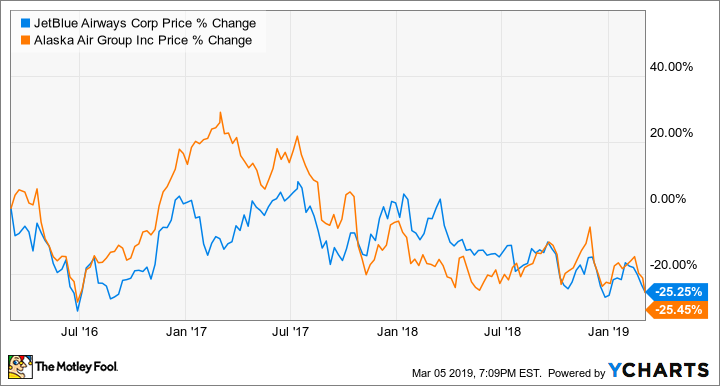Shares of JetBlue Airways (JBLU -1.55%) and Alaska Air (ALK 1.14%) have struggled in recent years, due to rising costs and subpar unit revenue results. In fact, both stocks have lost about a quarter of their value over the past three years, dramatically underperforming peers and the broader stock market.
However, JetBlue and Alaska seemed to be getting back on track toward the end of 2018. Both airlines posted solid unit revenue growth last quarter, beating their initial forecasts.
JetBlue Airways and Alaska Air Stock Performance, data by YCharts.
Unfortunately, that momentum hasn't continued into the first quarter of 2019 as expected. In conjunction with an investor conference, JetBlue Airways and Alaska Air both reduced their Q1 unit revenue forecasts on Tuesday.
JetBlue lowers its outlook
Back in January, JetBlue projected that Q1 revenue per available seat mile (RASM) would fall somewhere between being down 2% and up 1% year over year. Management said that excluding the RASM impact of winter storms in the first quarter of 2018 and a shift in the timing of Easter, this would translate to a 0.75% to 3.75% increase. The midpoint of that "adjusted" guidance would have been roughly in line with JetBlue's 2.4% RASM increase from the fourth quarter.
On Tuesday, JetBlue reduced the midpoint of its first-quarter RASM forecast by 2 percentage points, due to a slowdown in bookings that began in late January. The carrier now expects RASM to fall 1.5% to 3.5% this quarter, with most of the decline driven by a combination of weak demand in off-peak periods and low fares for last-minute bookings -- particularly on transcontinental routes and routes connecting Florida to the Caribbean.
JetBlue also noted a smaller impact from a recent State Department warning against travel to Haiti. Finally, it said that the Easter calendar shift is pushing even more revenue from the first quarter to the second quarter than it had initially expected.

JetBlue recently reduced its first quarter revenue guidance. Image source: JetBlue Airways.
On a brighter note, JetBlue said revenue headwinds should dissipate over the next two quarters, particularly because there will be more peak travel periods during the spring and summer. It also plans to trim its full-year capacity growth by 0.5 percentage points by cutting underperforming flights.
Similar trends at Alaska Air
Alaska Airlines also reduced the midpoint of its first-quarter RASM guidance by 2 percentage points on Tuesday. Whereas its initial outlook for the quarter called for a solid 2.5% to 4.5% unit revenue increase, the carrier now expects RASM to rise just 1% to 2%.
Like JetBlue, Alaska highlighted weak pricing for last-minute bookings on transcontinental flights from California to the East Coast. Severe winter storms in the Pacific Northwest (where Alaska Airlines is based) also affected unit revenue last month and caused a slowdown in bookings for the rest of the first quarter.
Still moving in the right direction
While the guidance reductions at JetBlue and Alaska Airlines represent setbacks, both carriers should still be able to deliver strong earnings growth in 2019 and beyond.
Indeed, JetBlue confirmed its forecast that adjusted earnings per share will rise to a range of $2.50 to $3.00 next year, up from just $1.55 in 2018. The combination of reallocating capacity away from a slew of underperforming markets and completing several key cost-saving initiatives will drive meaningful margin expansion for JetBlue beginning next quarter.
Meanwhile, Alaska Airlines' projected 1% to 2% RASM growth this quarter is still a solid result, considering the impact of the Easter shift. Furthermore, a variety of revenue-boosting initiatives and synergies from Alaska's late-2016 acquisition of Virgin America are set to kick in over the next few months. That should pave the way for meaningful margin expansion in 2019 and 2020.
Of course, there are no sure things in investing. But after their latest setbacks, shares of Alaska Air and JetBlue Airways trade for less than 10 times forward earnings. That provides a lot of cushion for investors in case the airlines face other unexpected setbacks later this year or in 2020.






